Abstract
The N-terminal amino acid sequences of the D-serine deaminases from strains of Escherichia coli K-12 that harbor wild-type and high-level constitutive catabolite-insensitive operator-initiator regions are identical: Met-Ser-GluNH2-Ser-Gly-Arg-His-Cys. This result indicates that the operator-initiator region is probably distinct from the D-serine deaminase structural gene.
Full text
PDF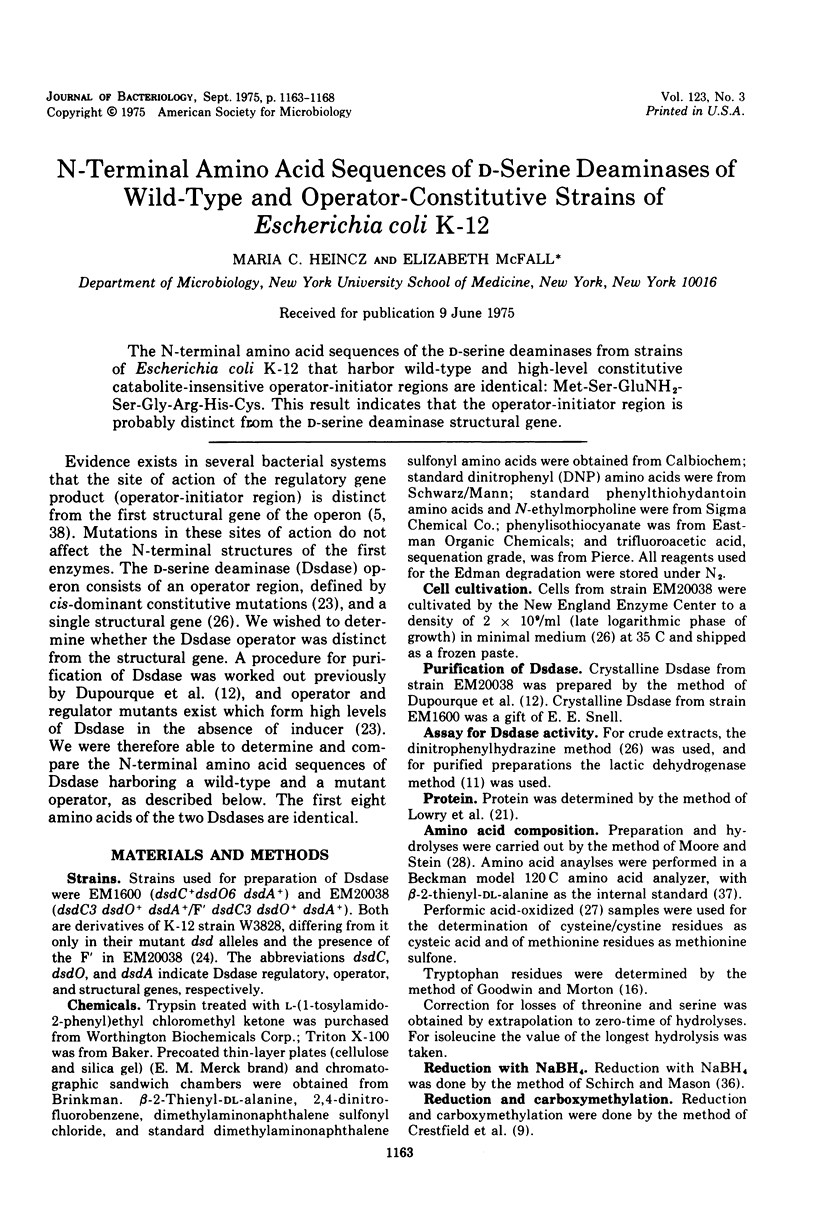
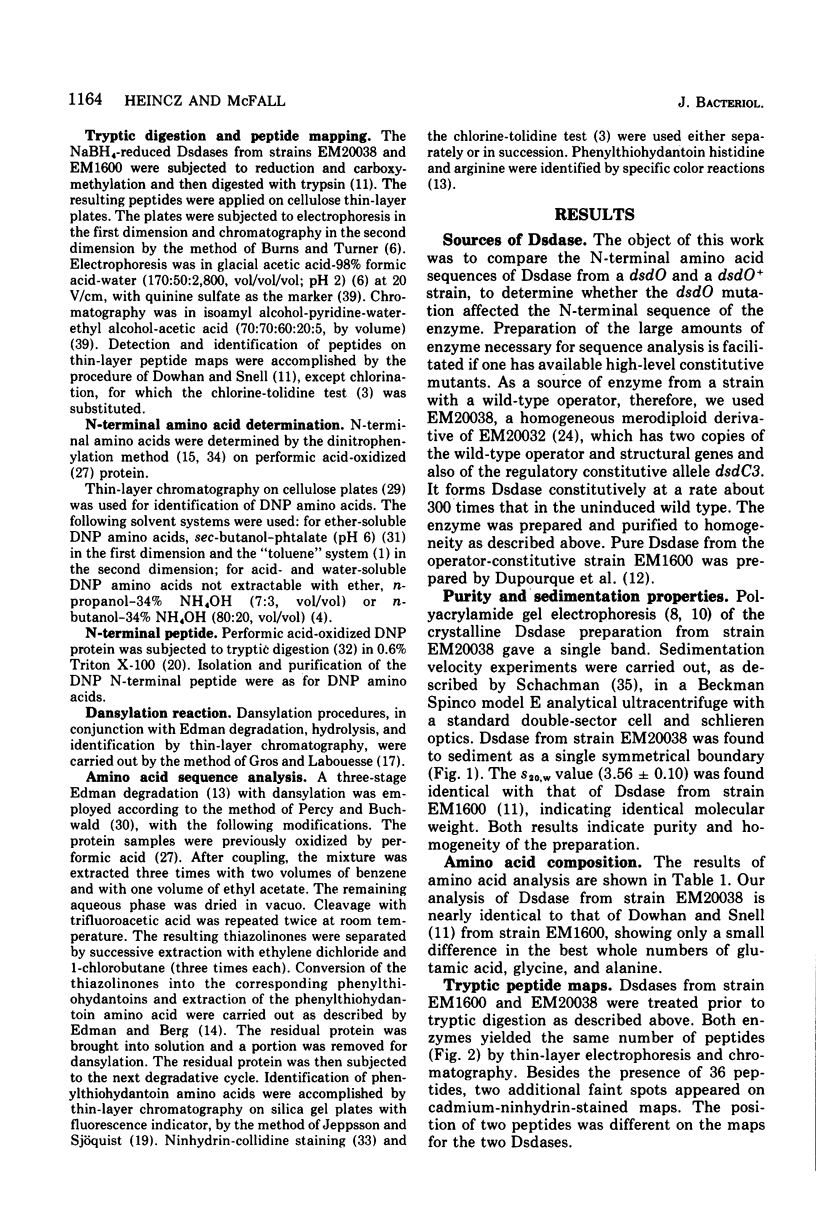
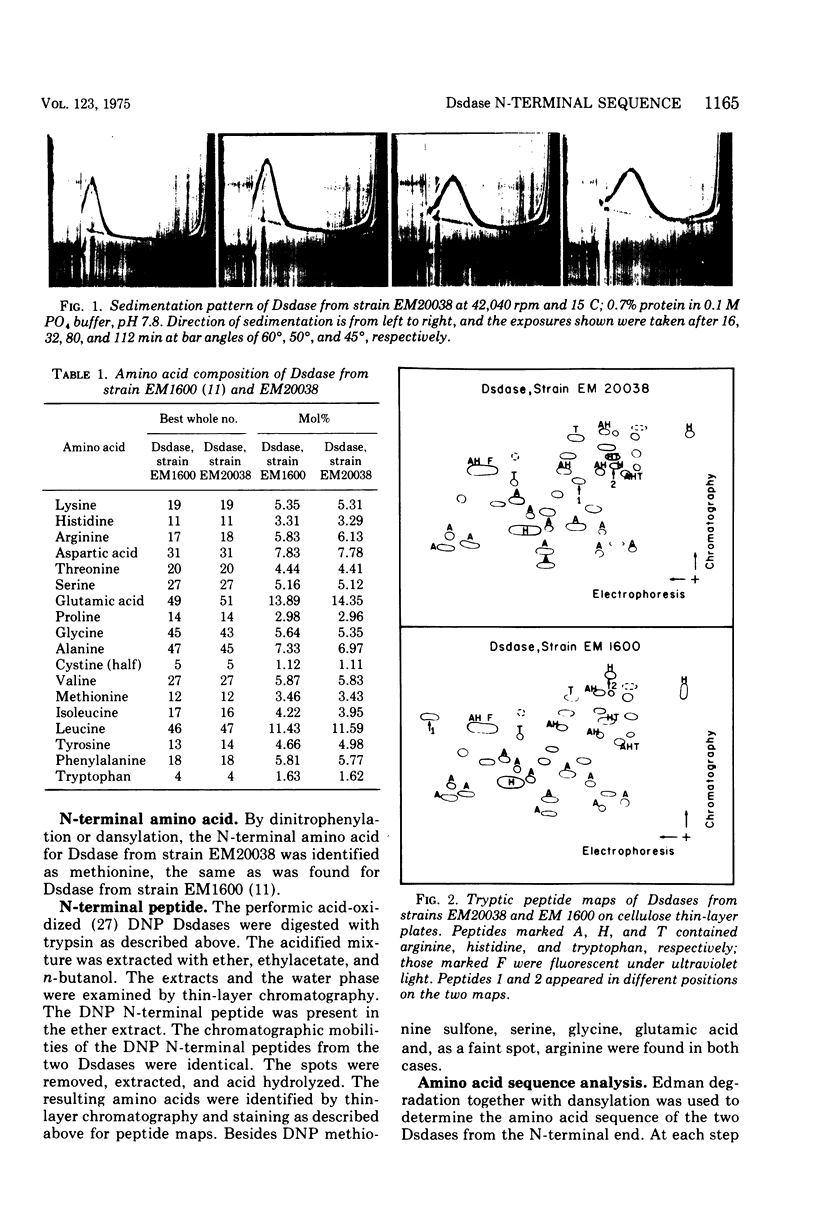
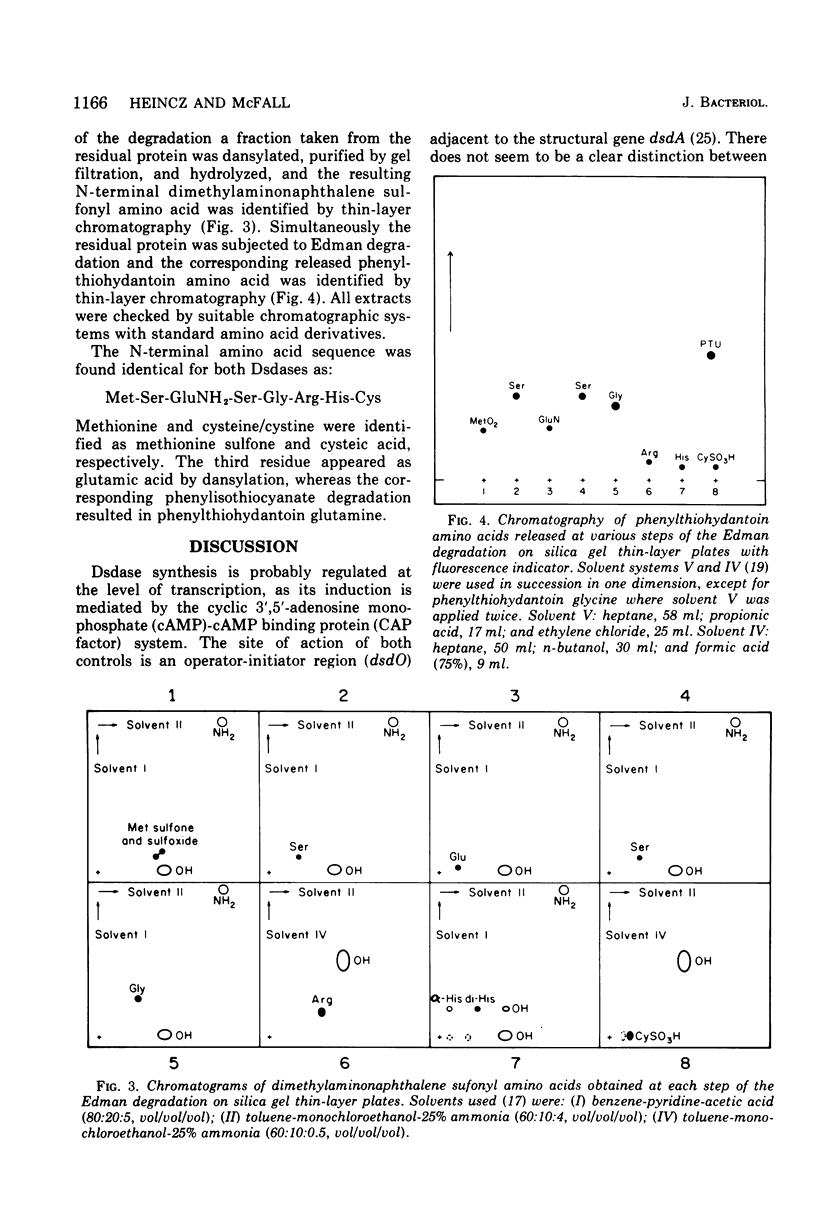
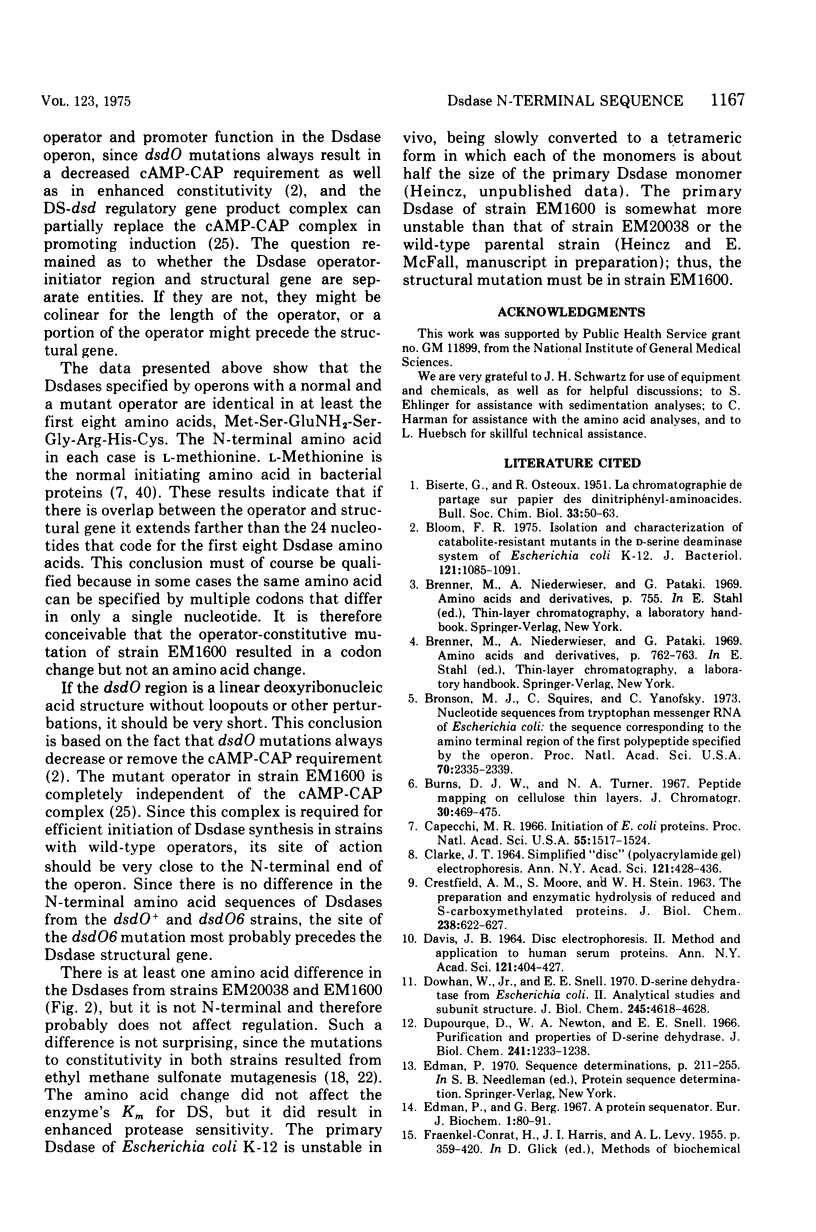
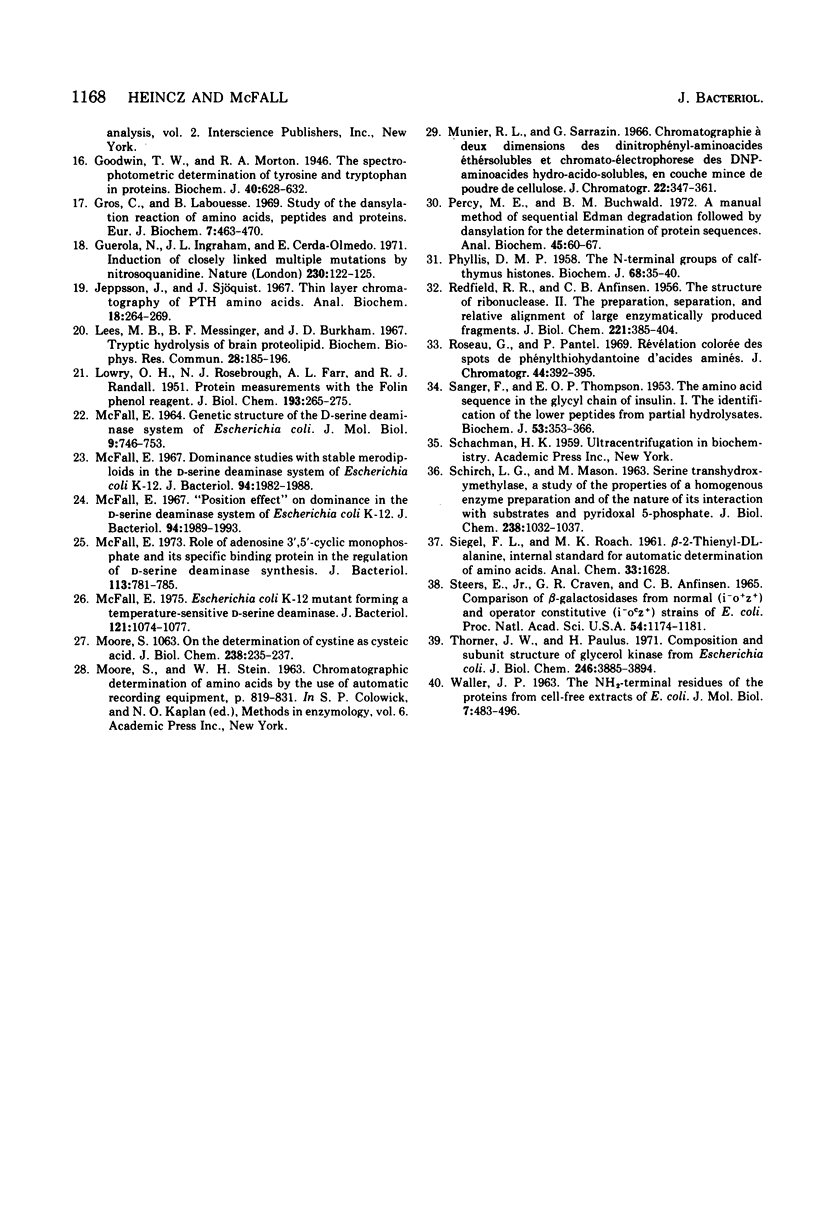
Images in this article
Selected References
These references are in PubMed. This may not be the complete list of references from this article.
- BISERTE G., OSTEUX R. La chromatographie de partage sur papier des dinitrophényl-aminoacides. Bull Soc Chim Biol (Paris) 1951;33(1-2):50–63. [PubMed] [Google Scholar]
- Bloom F. R. Isolation and characterization of catabolite-resistant mutants in the D-serine deaminase system of Escherichia coli K-12. J Bacteriol. 1975 Mar;121(3):1085–1091. doi: 10.1128/jb.121.3.1085-1091.1975. [DOI] [PMC free article] [PubMed] [Google Scholar]
- Bronson M. J., Squires C., Yanofsky C. Nucleotide sequences from tryptophan messenger RNA of Escherichia coli: the sequence corresponding to the amino-terminal region of the first polypeptide specified by the operon. Proc Natl Acad Sci U S A. 1973 Aug;70(8):2335–2339. doi: 10.1073/pnas.70.8.2335. [DOI] [PMC free article] [PubMed] [Google Scholar]
- Burns D. J., Turner N. A. Peptide mapping on cellulose thin layers. J Chromatogr. 1967 Oct;30(2):469–475. doi: 10.1016/s0021-9673(00)84179-5. [DOI] [PubMed] [Google Scholar]
- CLARKE J. T. SIMPLIFIED "DISC" (POLYACRYLAMIDE GEL) ELECTROPHORESIS. Ann N Y Acad Sci. 1964 Dec 28;121:428–436. doi: 10.1111/j.1749-6632.1964.tb14214.x. [DOI] [PubMed] [Google Scholar]
- CRESTFIELD A. M., MOORE S., STEIN W. H. The preparation and enzymatic hydrolysis of reduced and S-carboxymethylated proteins. J Biol Chem. 1963 Feb;238:622–627. [PubMed] [Google Scholar]
- Capecchi M. R. Initiation of E. coli proteins. Proc Natl Acad Sci U S A. 1966 Jun;55(6):1517–1524. doi: 10.1073/pnas.55.6.1517. [DOI] [PMC free article] [PubMed] [Google Scholar]
- DAVIS B. J. DISC ELECTROPHORESIS. II. METHOD AND APPLICATION TO HUMAN SERUM PROTEINS. Ann N Y Acad Sci. 1964 Dec 28;121:404–427. doi: 10.1111/j.1749-6632.1964.tb14213.x. [DOI] [PubMed] [Google Scholar]
- Dowhan W., Jr, Snell E. E. D-serine dehydratase from Escherichia coli. II. Analytical studies and subunit structure. J Biol Chem. 1970 Sep 25;245(18):4618–4628. [PubMed] [Google Scholar]
- Dupourque D., Newton W. A., Snell E. E. Purification and properties of D-serine dehydrase from Escherichia coli. J Biol Chem. 1966 Mar 10;241(5):1233–1238. [PubMed] [Google Scholar]
- Edman P., Begg G. A protein sequenator. Eur J Biochem. 1967 Mar;1(1):80–91. doi: 10.1007/978-3-662-25813-2_14. [DOI] [PubMed] [Google Scholar]
- Edman P. Sequence determination. Mol Biol Biochem Biophys. 1970;8:211–255. doi: 10.1007/978-3-662-12834-3_8. [DOI] [PubMed] [Google Scholar]
- FRAENKEL-CONRAT H., HARRIS J. I., LEVY A. L. Recent developments in techniques for terminal and sequence studies in peptides and proteins. Methods Biochem Anal. 1955;2:359–425. doi: 10.1002/9780470110188.ch12. [DOI] [PubMed] [Google Scholar]
- Goodwin T. W., Morton R. A. The spectrophotometric determination of tyrosine and tryptophan in proteins. Biochem J. 1946;40(5-6):628–632. doi: 10.1042/bj0400628. [DOI] [PMC free article] [PubMed] [Google Scholar]
- Gros C., Labouesse B. Study of the dansylation reaction of amino acids, peptides and proteins. Eur J Biochem. 1969 Feb;7(4):463–470. doi: 10.1111/j.1432-1033.1969.tb19632.x. [DOI] [PubMed] [Google Scholar]
- Guerola N., Ingraham J. L., Cerdá-Olmedo E. Induction of closely linked multiple mutations by nitrosoguanidine. Nat New Biol. 1971 Mar 24;230(12):122–125. doi: 10.1038/newbio230122a0. [DOI] [PubMed] [Google Scholar]
- LOWRY O. H., ROSEBROUGH N. J., FARR A. L., RANDALL R. J. Protein measurement with the Folin phenol reagent. J Biol Chem. 1951 Nov;193(1):265–275. [PubMed] [Google Scholar]
- Lees M. B., Messinger B. F., Burnham J. D. Tryptic hydrolysis of brain proteolipid. Biochem Biophys Res Commun. 1967 Jul 21;28(2):185–190. doi: 10.1016/0006-291x(67)90427-5. [DOI] [PubMed] [Google Scholar]
- MCFALL E. GENETIC STRUCTURE OF THE D-SERINE DEAMINASE SYSTEM OF ESCHERICHIA COLI. J Mol Biol. 1964 Sep;9:746–753. doi: 10.1016/s0022-2836(64)80179-0. [DOI] [PubMed] [Google Scholar]
- McFall E. "Position effect" on dominance in the D-serine deaminase system of Escherichia coli K-12. J Bacteriol. 1967 Dec;94(6):1989–1993. doi: 10.1128/jb.94.6.1989-1993.1967. [DOI] [PMC free article] [PubMed] [Google Scholar]
- McFall E. Dominance studies with stable merodiploids in the D-serine deaminase system of Escherichia coli K-12. J Bacteriol. 1967 Dec;94(6):1982–1988. doi: 10.1128/jb.94.6.1982-1988.1967. [DOI] [PMC free article] [PubMed] [Google Scholar]
- McFall E. Escherichia coli K-12 mutant forming a temperature-sensitive D-serine deaminase. J Bacteriol. 1975 Mar;121(3):1074–1077. doi: 10.1128/jb.121.3.1074-1077.1975. [DOI] [PMC free article] [PubMed] [Google Scholar]
- McFall E. Role of adenosine 3',5'-cyclic monophosphate and its specific binding protein in the regulation of D-serine deaminase synthesis. J Bacteriol. 1973 Feb;113(2):781–785. doi: 10.1128/jb.113.2.781-785.1973. [DOI] [PMC free article] [PubMed] [Google Scholar]
- Munier R. L., Sarrazin G. Chromatographie à deux dimensions des dinitrophényl-aminoacides éthérosolubles et chromato-électrophorèse dex DNP-aminoacides hydro-acido-solubles, en couch mince de poudre d cellulose. J Chromatogr. 1966 May;22(2):347–361. doi: 10.1016/s0021-9673(01)97108-0. [DOI] [PubMed] [Google Scholar]
- PHILLIPS D. M. The N-terminal groups of calf-thymus histones. Biochem J. 1958 Jan;68(1):35–40. doi: 10.1042/bj0680035. [DOI] [PMC free article] [PubMed] [Google Scholar]
- Percy M. E., Buchwald B. M. A manual method of sequential Edman degradation followed by dansylation for the determination of protein sequences. Anal Biochem. 1972 Jan;45(1):60–67. doi: 10.1016/0003-2697(72)90007-3. [DOI] [PubMed] [Google Scholar]
- REDFIELD R. R., ANFINSEN C. B. The structure of ribonuclease. II. The preparation, separation, and relative alignment of large enzymatically produced fragments. J Biol Chem. 1956 Jul;221(1):385–404. [PubMed] [Google Scholar]
- Roseau G., Pantel P. Révélation colorée des spots de phénylthiohydantoïne d'acides aminés. J Chromatogr. 1969 Oct 28;44(2):392–395. doi: 10.1016/s0021-9673(01)92553-1. [DOI] [PubMed] [Google Scholar]
- SANGER F., THOMPSON E. O. P. The amino-acid sequence in the glycyl chain of insulin. I. The identification of lower peptides from partial hydrolysates. Biochem J. 1953 Feb;53(3):353–366. doi: 10.1042/bj0530353. [DOI] [PMC free article] [PubMed] [Google Scholar]
- SCHIRCH L. G., MASON M. Serine transhydroxymethylase. A study of the properties of a homogeneous enzyme preparation and of the nature of its interaction with substrates and pyridoxal 5-phosphate. J Biol Chem. 1963 Mar;238:1032–1037. [PubMed] [Google Scholar]
- Steers E., Jr, Craven G. R., Anfinsen C. B. Comparison of beta-galactosidases from normal (i-o+z+) and operator constitutive (i-ocz+) strains of E. coli. Proc Natl Acad Sci U S A. 1965 Oct;54(4):1174–1181. doi: 10.1073/pnas.54.4.1174. [DOI] [PMC free article] [PubMed] [Google Scholar]
- Thorner J. W., Paulus H. Composition and subunit structure of glycerol kinase from Escherichia coli. J Biol Chem. 1971 Jun 25;246(12):3885–3894. [PubMed] [Google Scholar]
- WALLER J. P. THE NH2-TERMINAL RESIDUES OF THE PROTEINS FROM CELL-FREE EXTRACTS OF E. COLI. J Mol Biol. 1963 Nov;7:483–496. doi: 10.1016/s0022-2836(63)80096-0. [DOI] [PubMed] [Google Scholar]



